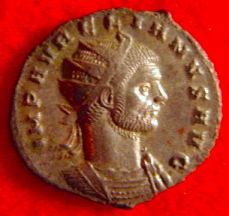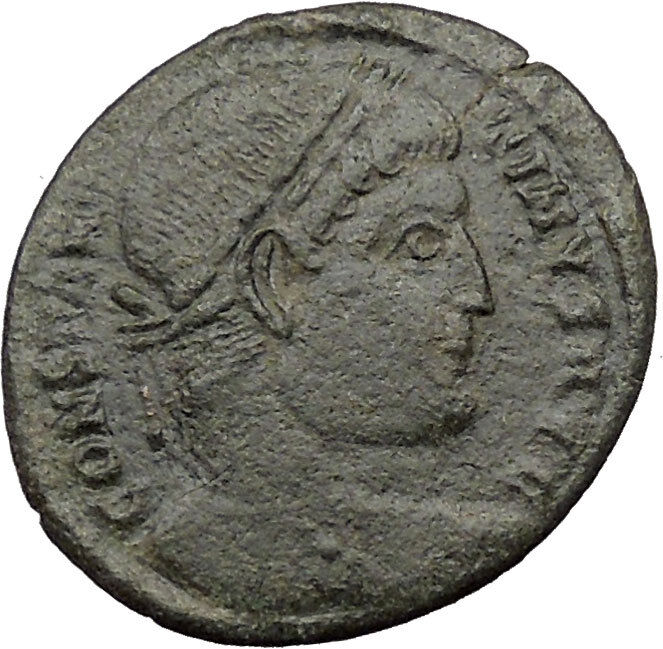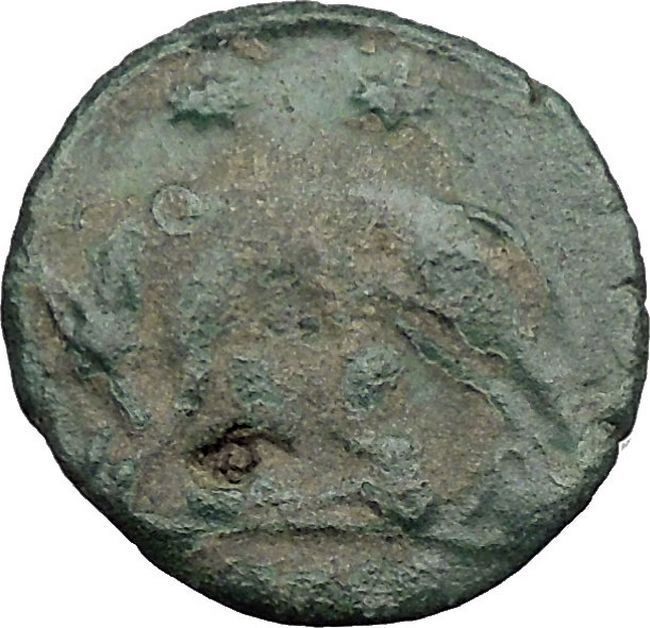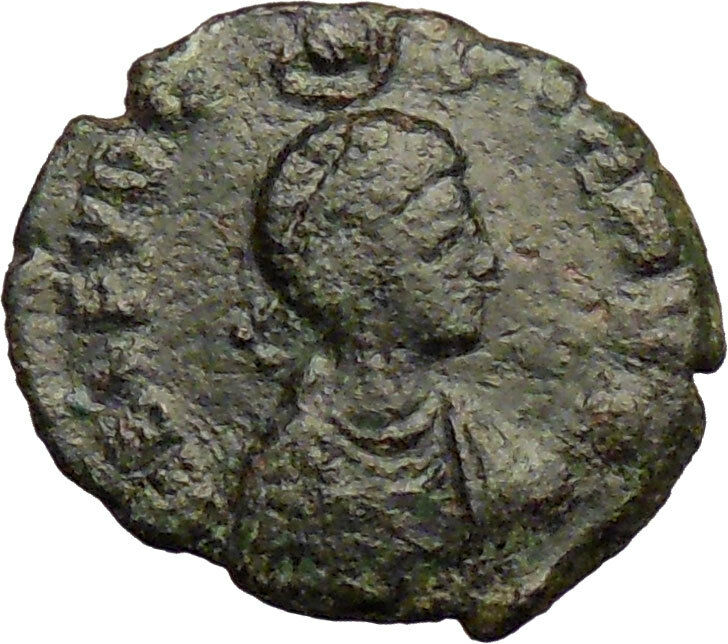|
Aurelian
–
Roman Emperor
: 270-275 A.D.
Bronze Antoninianus 21mm (3.71 grams) Struck circa 270-275 A.D.
IMP AVRELIANVS AVG, radiate, draped & cuirassed bust right
RESTITVT ORBIS, woman standing right, presenting wreath to Aurelian.
You are bidding on the exact item pictured,
provided with a Certificate of Authenticity and Lifetime Guarantee of
Authenticity.
Aurelian (Latin:
Lucius Domitius Aurelianus Augustus;
9 September 214 or 215 – September or October 275), was
Roman Emperor
from 270 to 275. During his
reign, he defeated the
Alamanni
after a devastating war.

He also defeated the
Goths
,
Vandals
,
Juthungi
,
Sarmatians
, and
Carpi
. Aurelian restored the Empire’s eastern
provinces after his conquest of the
Palmyrene Empire
in 273. The following year he
conquered the
Gallic Empire
in the west, reuniting the Empire
in its entirety. He was also responsible for the construction of the
Aurelian Walls
in
Rome, and the abandonment of the province of
Dacia
. His successes effectively ended the
Roman Empire’s
Crisis of the Third Century
, earning him the
title Restitutor Orbis or ‘Restorer of the World’. Although
Domitian
was the first Emperor who had demanded
to be officially hailed as dominus et deus (master and god), these titles
never occurred in written form on official documents until the reign of
Aurelian..
Early life and rise
to power
Aurelian was born in
Serdica
(today
Sofia
in
Bulgaria
) in
Moesia
or what was later called
Dacia Ripensis
[4][5]
to an obscure provincial family; his father was
tenant
to a
senator
named Aurelius, who gave his name to
the family.Aurelian probably joined the army in 235 at around age twenty. He
distinguished himself in several wars during the tumultuous mid-century; his
successes as a cavalry commander ultimately made him a member of emperor
Gallienus
‘ entourage. In 268, Aurelian and his
cavalry participated in general
Claudius
‘ victory over the
Goths
at the
Battle of Naissus
.[8]
Later that year Gallienus traveled to Italy and fought
Aureolus
, his former general and now usurper
for the throne. Driving Aureolus back into
Mediolanum
, Gallienus promptly besieged his
adversary in the city. However, while the siege was ongoing the Emperor was
assassinated. One source says Aurelian, who was present at the siege,
participated and supported general Claudius for the purple – which is plausible.[9]
Aurelian was married to
Ulpia Severina
, about whom little is known.
Like Aurelian she was from
Dacia
.[10]
They are known to have had a daughter together.[11]
Service under Claudius
Claudius was acclaimed Emperor by the soldiers outside Mediolanum. The new
Emperor immediately ordered the senate to deify Gallienus.[12]
Next, he began to distance himself from those responsible for his predecessor’s
assassination, ordering the execution of those directly involved.[12]
Aureolus was still besieged in Mediolanum and sought reconciliation with the new
emperor, but Claudius had no sympathy for a potential rival. The emperor had
Aureolus killed and one source implicates Aurelian in the deed, perhaps even
signing the warrant for his death himself.[12]
During the reign of Claudius, Aurelian was promoted rapidly: he was given
command of the elite Dalmatian cavalry, and was soon promoted to overall Master
of Horse, effectively the head of the army after the Emperor – the Emperor’s
position before his acclamation.[12]
The war against Aureolus and the concentration of forces in Italy allowed the
Alamanni
to break through the
Rhaetian limes
along the upper
Danube
. Marching through
Raetia
and the
Alps unhindered, they entered northern Italy and began pillaging the
area. In early 269, emperor Claudius and Aurelian marched north to meet the
Alamanni, defeating them decisively at the
Battle of Lake Benacus
.[13]
While still dealing with the defeated enemy, news came from the
Balkans
reporting large-scale attacks from the
Heruli
,
Goths
,
Gepids
, and
Bastarnae
.[13]
Claudius immediately dispatched Aurelian to the Balkans to contain the invasion
as best he could until Claudius could arrive with his main army.[14]
The Goths were besieging
Thessalonica
when they heard of emperor
Claudius’ approach, causing them to abandon the siege and pillage north-eastern
Macedonia. Aurelian intercepted the Goths with his Dalmatian cavalry and
defeated them in a series of minor skirmishes, killing as many as three thousand
of the enemy.[14]
Aurelian continued to harass the enemy, driving them northward into
Upper Moesia
where emperor Claudius had
assembled his main army. The ensuing battle was indecisive: the northward
advance of the Goths was halted but Roman losses were heavy.[14]
Claudius could not afford another pitched battle, so he instead laid a
successful ambush, killing thousands. However, the majority of the Goths escaped
and began retreating south the way they had come. For the rest of year, Aurelian
harassed the enemy with his Dalmatian cavalry.[15]
Now stranded in Roman territory, the Goths’ lack of provisions began to take
its toll. Aurelian, sensing his enemies’ desperation, attacked them with the
full force of his cavalry, killing many and driving the remainder westward into
Thrace
.[15]
As winter set in, the Goths retreated into the
Haemus Mountains
, only to find themselves
trapped and surrounded. The harsh conditions now exacerbated their shortage of
food. However, the Romans underestimated the Goths and let their guard down,
allowing the enemy to break through their lines and escape. Apparently emperor
Claudius ignored advice, perhaps from Aurelian, and withheld the cavalry and
sent in only the infantry to stop their break-out.
The determined Goths killed many of the oncoming infantry and were only
prevented from slaughtering them all when Aurelian finally charged in with his
Dalmatian cavalry. The Goths still managed to escape and continued their march
through Thrace.[15]
The Roman army continued to follow the Goths during the spring and summer of
270. Meanwhile, a devastating plague swept through the Balkans, killing many
soldiers in both armies.
Emperor Claudius fell ill on the march to the battle and returned to his
regional headquarters in Sirmium, leaving Aurelian in charge of operations
against the Goths.[15]
Aurelian used his cavalry to great effect, breaking the Goths into smaller
groups which were easier to deal with. By late summer the Goths were defeated:
any survivors were stripped of their animals and booty and were levied into the
army or settled as farmers in frontier regions.[15]
Aurelian had no time to relish his victories; in late August news arrived from
Sirmium that emperor Claudius was dead.[16]
Opposition to
Quintillus
When Claudius died, his brother
Quintillus
seized power with support of the
Senate. With an act typical of the
Crisis of the Third Century
, the army refused
to recognize the new Emperor, preferring to support one of its own commanders:
Aurelian was proclaimed emperor in September 270 by the
legions
in Sirmium. Aurelian defeated
Quintillus’ troops, and was recognized as Emperor by the Senate after
Quintillus’ death. The claim that Aurelian was chosen by Claudius on his death
bed[17]
can be dismissed as propaganda; later, probably in 272, Aurelian put his own
dies imperii the day of Claudius’ death, thus implicitly considering
Quintillus a
usurper
.[18]
With his base of power secure, he now turned his attention to Rome’s greatest
problems — recovering the vast territories lost over the previous two decades,
and reforming the res publica.
Conqueror and reformer

Aurelian was a military commander, and during his reign he tried to
keep legions’ fidelity; this coin celebrated the CONCORDIA MILITVM,
“concord of the soldiers” – in other words, “harmony between the
emperor and the military”. Ironically, he was killed by
Praetorian Guards
.
In 248, Emperor
Philip the Arab
had celebrated the millennium
of the city of Rome with great and expensive ceremonies and games, and the
Empire had given a tremendous proof of self-confidence. In the following years,
however, the Empire had to face a huge pressure from external enemies, while, at
the same time, dangerous civil wars threatened the empire from within, with
usurpers weakening the strength of the state. Also, the economical substrate of
the state, agriculture and commerce, suffered from the disruption caused by the
instability. On top of this an epidemic swept through the Empire around 250,
greatly diminishing manpower both for the army and for agriculture.
The end result was that the Empire could not endure the blow of the capture
of Emperor
Valerian
in 260. The eastern provinces found
their protectors in the rulers of the city of
Palmyra
, in
Syria
, whose autonomy grew until the formation
of the
Palmyrene Empire
, which was more successful
against the Persian threat. The western provinces, those facing the
limes
of the
Rhine
, seceded to form a third, autonomous
state within the territories of the Roman Empire, which is now known as the
Gallic Empire
.
In Rome, the Emperor was occupied with the internal menaces to his power and
with the defence of
Italia
and the Balkans. This was the situation
faced by Gallienus and Claudius, and the problems Aurelian had to deal with at
the beginning of his rule.[19]
Reunification of
the empire
The first actions of the new Emperor were aimed at strengthening his own
position in his territories. Late in 270, Aurelian campaigned in northern
Italia
against the
Vandals
,
Juthungi
, and
Sarmatians
, expelling them from Roman
territory. To celebrate these victories, Aurelian was granted the title of
Germanicus Maximus.[20]
The authority of the Emperor was challenged by several
usurpers
—
Septimius
,
Urbanus
,
Domitianus
, and the rebellion of
Felicissimus
— who tried to exploit the sense
of insecurity of the empire and the overwhelming influence of the armies in
Roman politics. Aurelian, being an experienced commander, was aware of the
importance of the army, and his propaganda, known through his coinage, shows he
wanted the support of the legions.[18]
Defeat of the Alamanni
The burden of the northern barbarians was not yet over, however. In 271, the
Alamanni
moved towards Italia, entering the Po
plain and sacking the villages; they passed the
Po River
, occupied
Placentia
and moved towards
Fano. Aurelian, who was in Pannonia to control
Vandals
‘ withdrawal, quickly entered Italia,
but his army was defeated in an
ambush near Placentia
(January 271). When the
news of the defeat arrived in Rome, it caused great fear for the arrival of the
barbarians. But Aurelian attacked the Alamanni camping near the
Metaurus River
, defeating them in the
Battle of Fano
, and forcing them to re-cross
the Po river; Aurelian finally routed them at
Pavia
. For this, he received the title
Germanicus Maximus. However, the menace of the German people remained high
as perceived by the Romans, so Aurelian resolved to build the walls that became
known as the
Aurelian Walls
around
Rome.[21]

The Porta Asinara, a gate in the
Aurelian Walls
.
The emperor led his legions to the Balkans, where he defeated and routed the
Goths beyond the Danube, killing the Gothic leader
Cannabaudes
, and assuming the title of
Gothicus Maximus. However, he decided to abandon the province of
Dacia
, on the exposed north bank of the Danube,
as too difficult and expensive to defend. He reorganised a new province of Dacia
south of the Danube, inside the former
Moesia
, called
Dacia Aureliana
, with
Serdica
as the capital.[22]
Conquest of
the Palmyrene Empire

Aurelian, personification of
Sol
, defeats the Palmyrene Empire,
and celebrates ORIENS AVG – oriens Augusti: the rising
sun/star of Augustus.
In 272, Aurelian turned his attention to the lost eastern provinces of the
empire, the so-called “Palmyrene
Empire” ruled by Queen
Zenobia
from the city of
Palmyra
.[23]
Zenobia had carved out her own empire, encompassing
Syria
,
Palestine
,
Egypt
and large parts of
Asia Minor
. The Egyptian queen cut off Rome’s
shipments of grain, and in a matter of weeks, the Romans started running low on
bread. In the beginning, Aurelian had been recognized as Emperor, while
Vaballathus
, the son of Zenobia, hold the title
of rex and imperator (“king” and “supreme military commander”),
but Aurelian decided to invade the eastern provinces as soon as he felt his army
to be strong enough.
Asia Minor was recovered easily; every city but
Byzantium
and
Tyana
surrendered to him with little
resistance. The fall of Tyana lent itself to a legend: Aurelian to that point
had destroyed every city that resisted him, but he spared Tyana after having a
vision of the great 1st-century philosopher
Apollonius of Tyana
, whom he respected greatly,
in a dream.
Apollonius implored him, stating, “Aurelian, if you desire to rule, abstain
from the blood of the innocent! Aurelian, if you will conquer, be merciful!”
Whatever the reason, Aurelian spared Tyana. It paid off; many more cities
submitted to him upon seeing that the Emperor would not exact revenge upon them.
Within six months, his armies stood at the gates of Palmyra, which surrendered
when Zenobia tried to flee to the
Sassanid Empire
. The “Palmyrene Empire” was no
more.
Eventually Zenobia and her son were captured and made to walk on the streets
of Rome in his triumph. With the grain stores once again shipped to Rome,
Aurelian’s soldiers handed out free bread to the citizens of the city, and the
Emperor was hailed a hero by his subjects. After a brief clash with the Persians
and another in Egypt against usurper
Firmus
, Aurelian was obliged to return to
Palmyra in 273 when that city rebelled once more. This time, Aurelian allowed
his soldiers to sack the city, and Palmyra never recovered. More honors came his
way; he was now known as Parthicus Maximus and Restitutor Orientis
(“Restorer of the East”).[18]
The rich province Egypt was also recovered by Aurelian. The Brucheion (Royal
Quarter) in Alexandria was burned to the ground. This section of the city once
contained the
Library of Alexandria
, although it is not known
if the Library still existed in Aurelian’s time. (It had already been damaged by
fire during the visit of
Julius Caesar
to Alexandria.)
Conquest of the
Gallic Empire
In 274, the victorious emperor turned his attention to the west, and the “Gallic
Empire” which had already been reduced in size by Claudius II.
Aurelian won this campaign largely through diplomacy; the “Gallic Emperor”
Tetricus
was willing to abandon his throne and
allow Gaul and Britain to return to the Empire, but could not openly submit to
Aurelian. Instead, the two seem to have conspired so that when the armies met at
Châlons-en-Champagne
that autumn, Tetricus
simply deserted to the Roman camp and Aurelian easily defeated the Gallic army
facing him. Tetricus was rewarded for his part in the conspiracy with a
high-ranking position in Italy itself.
Aurelian returned to Rome and won his last honorific from the Senate –
Restitutor Orbis (“Restorer of the World”). In four years, he had secured
the frontiers of the Empire and reunified it, effectively giving the Empire a
new lease on life that lasted 200 years.
Reformations
Aurelian was a reformer, and settled many important functions of the imperial
apparatus, including the economy and the religion. He also restored many public
buildings, re-organized the management of the food reserves, set fixed prices
for the most important goods, and prosecuted misconduct by the public officers.
Religious reform
Aurelian strengthened the position of the Sun god
Sol Invictus
as the main divinity of the Roman
pantheon. His intention was to give to all the peoples of the Empire, civilian
or soldiers, easterners or westerners, a single god they could believe in
without betraying their own gods. The center of the cult was a new temple, built
in 274 in the
Campus Agrippae
in Rome, with great
decorations financed by the spoils of the Palmyrene Empire.
Aurelian did not persecute other religions.[citation
needed] However, during his short rule, he seemed to
follow the principle of “one god, one empire”, that was later adopted to a full
extent by
Constantine
. He appears with the title deus
et dominus natus (“God and born ruler”) on some of his coins, a style also
later adopted by Diocletian.
Lactantius
argued that Aurelian would have
outlawed all the other gods if he had had enough time; he was recorded by
Christian historians as having organized persecutions.[24]
Felicissimus’ rebellion and coinage reform
Aurelian’s reign records the only uprising of mint workers. The
rationalis
Felicissimus
, a senior public financial
official whose responsibilities included supervision of the mint at Rome,
revolted against Aurelian. The revolt seems to have been caused by the fact that
the mint workers, and Felicissimus first, were accustomed to stealing the silver
for the coins and producing coins of inferior quality. Aurelian wanted to
eliminate this, and put Felicissimus under trial. The rationalis incited
the mintworkers to revolt: the rebellion spread in the streets, even if it seems
that Felicissimus was killed immediately, presumably executed.
The Palmyrene rebellion in Egypt had probably reduced the
grain supply to Rome
, thus disaffecting the
population with respect to the emperor. This rebellion also had the support of
some senators, probably those who had supported the election of
Quintillus
, and thus had something to fear from
Aurelian.
Aurelian ordered the urban cohorts, reinforced by some regular troops of the
imperial army, to attack the rebelling mob: the resulting battle, fought on the
Caelian hill
, marked the end of the revolt,
even if at a high price (some sources give the figure, probably exaggerated, of
7,000 casualties). Many of the rebels were executed; also some of the rebelling
senators were put to death. The mint of Rome was closed temporarily, and the
institution of several other mints caused the main mint of the empire to lose
its hegemony.[25]
His monetary reformation included in the introduction of
antoninianii
containing 5% silver. They
bore the mark XXI (or its Greek numerals form KA),
which meant that twenty of such coins would contain the same silver quantity of
an old silver
denarius
.[26]
Considering that this was an improvement over the previous situation gives an
idea of the severity of the economic situation Aurelian faced. The Emperor
struggled to introduce the new “good” coin by recalling all the old “bad” coins
prior to their introduction.[18]
Death

Ulpia Severina
, wife of Aurelian
and
Augusta
since 274. Holder of
the title of mater castrorum et senatus et patriae, typical
of the women of the
Severan dynasty
. Severina possibly
ruled alone between Aurelian’s death and Tacitus’ election, thus
being the only Roman Empress ruling in her own right.
In 275, Aurelian marched towards Asia Minor, preparing another campaign
against the Sassanids: the deaths of Kings
Shapur I
(272) and
Hormizd I
(273) in quick succession, and the
rise to power of a weakened ruler (Bahram
I), set the possibility to attack the Sassanid Empire.
On his way, the Emperor suppressed a revolt in Gaul — possibly against
Faustinus, an officer or usurper of Tetricus — and defeated barbarian marauders
in Vindelicia
(Germany).
However, Aurelian never reached Persia, as he was murdered while waiting in
Thrace to cross into Asia Minor. As an administrator, Aurelian had been very
strict and handed out severe punishments to corrupt officials or soldiers. A
secretary of Aurelian (called Eros by
Zosimus
) had told a lie on a minor issue. In
fear of what the Emperor might do, he forged a document listing the names of
high officials marked by the emperor for execution, and showed it to
collaborators. The notarius Mucapor and other high-ranking officers of
the
Praetorian Guard
, fearing punishment from the
Emperor, murdered him in September 275, in
Caenophrurium
, Thrace (modern Turkey).
Aurelian’s enemies in the Senate briefly succeeded in passing
damnatio memoriae
on the Emperor, but this
was reversed before the end of the year and Aurelian, like his predecessor
Claudius II, was deified as Divus Aurelianus.
There is substantial evidence that Aurelian’s wife
Ulpia Severina
, who had been declared
Augusta
in 274, may have ruled the Empire
by her own power for some time after his death.[10][11]
The sources indicate that there was an
interregnum
between Aurelian’s death and the
election of
Marcus Claudius Tacitus
as his successor.
Additionally, some of Ulpia’s coins appear to have been minted after Aurelian’s
death.[11]
Legacy
Aurelian’s short reign reunited a fragmented Empire while saving Rome from
barbarian invasions that had reached Italy itself. His death prevented a full
restoration of political stability and a lasting dynasty that could end the
cycle of assassination of Emperors and civil war that marked this period. Even
so, he brought the Empire through a very critical period in its history, and
without Aurelian it never would have survived the invasions and fragmentation of
the decade in which he reigned. Twenty years later the reign of
Diocletian
would fully restore stability and
end the
Crisis of the third century
. The Western half
would survive another two hundred years, while the East would last another
millennium.
The city of Orléans
in France is named after Aurelian.
Originally named Cenabum
, Aurelian rebuilt and named it
Aurelianum or Aureliana Civitas (“city of Aurelian”, cité
d’Aurélien), which evolved into Orléans.[27]
|













